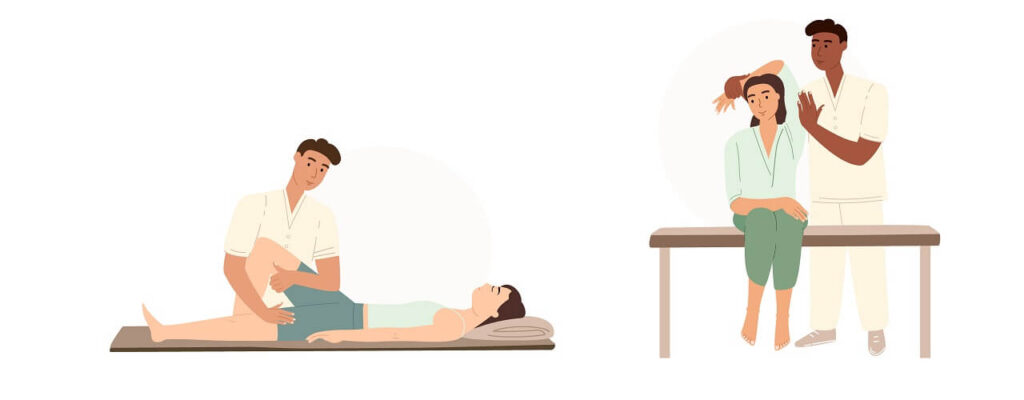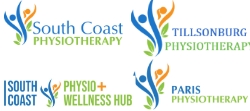Unlocking the Power of Touch: Exploring Different Types of Manual Therapy Techniques

The idea that touch can be healing may sound a bit fanciful to some, but science actually backs it up. Several studies show that touch can have a beneficial effect in medical settings, providing comfort and reassurance to anxious patients. Physiotherapists have understood this concept for a long time, and over the years, several types of manual therapy techniques–that is, touch-based techniques–have become synonymous with the field.
In fact, manual therapy is one of the foundations of physiotherapy, right alongside therapeutic exercise. Physiotherapists use it to reduce pain, restore mobility, improve circulation–and, of course, offer comfort and reassurance.
But what exactly is manual therapy? While definitions can vary slightly, it’s a set of techniques that utilize a hands-on approach to examination and treatment. Physiotherapists incorporate it with other common approaches, such as exercise, patient education, or physiotherapy modalities, to create a comprehensive, personalized care plan.
At South Coast Physiotherapy, we pride ourselves on using manual therapy techniques. If you’d like to learn more about how we utilize touch and manual therapy in our practice, call our (town) clinic to schedule an appointment. Or keep reading for a quick, informative overview!
Different Types of Manual Therapy Techniques
“Manual therapy” is an umbrella term that refers to several different hands-on techniques. Our physiotherapists will decide which techniques to use based on your symptoms, conditions, pain levels, and overall goals.
Here are some of the most common forms of manual therapy:
- Soft tissue mobilization: This technique focuses on your body’s soft tissue–your muscles, ligaments, and tendons. In an approach similar to therapeutic massage, we’ll gently mobilize the affected tissue to restore movement and reduce tension.
- Joint mobilization: This technique targets your body’s joints. A physiotherapist will gently guide an impaired joint through its current range of motion, helping to improve function and mobility.
- Joint manipulation: Joint manipulation is a slightly more forceful version of joint mobilization. In this technique, the physiotherapist sharply thrusts the joint through its current range of motion, resulting in a popping sound–plus reduced pain and improved mobility.
- Myofascial release: Your myofascia is a tough, thick tissue that wraps and protects your muscles. Restriction in the fascia can be painful, so a myofascial release involves manually stretching the tissue to release that restriction and alleviate muscle tension.
- Trigger point therapy: Trigger points are tender nodules (or “knots”) in your fascia and can cause pain throughout your body. Physiotherapists will use their hands to apply gentle pressure to these trigger points to reduce pain and improve muscle function.
One thing all of these techniques have in common is that they’re performed with the physiotherapist’s hands. While we may occasionally utilize tools (known as instrument-assisted manual therapy or IAMT) to help with particularly stubborn areas, for the most part, everything will be hands-on. That way, you receive not only the benefits of the technique itself but also that of human touch.
What Types of Conditions Can Manual Therapy Techniques Help?
We typically use manual therapy to prepare your body for more intense treatments. Most musculoskeletal disorders benefit immensely from targeted movement, but if your pain is too intense to exercise, manual therapy can help manage your pain and mobility limitations as you build your strength and stamina.
That said, several conditions can benefit from manual therapy, including the following:
- Chronic Pain Conditions: Many chronic pain conditions can benefit from different types of manual therapy techniques, including notoriously difficult-to-address conditions like fibromyalgia. Manual therapy can also help with lower back pain, neck pain, other types of joint pain, and more.
- Headaches /Migraines: Many headache and migraine sufferers find that certain manual therapy techniques, including spinal mobilizations and manipulations and trigger point therapy, can help manage their pain.
- Soft Tissue Injuries: Have you strained a hamstring or sprained a wrist? Strains (damage to the muscles or tendons) and strains (damage to the ligaments) can both benefit from mobilization techniques, helping reduce pain and facilitate healing.
- Post-Surgical Rehabilitation: Manual therapy plays a big role in helping you manage pain and discomfort after orthopedic surgery. Joint mobilization, in particular, will help you restore your range of motion as you begin your rehabilitation program.
The different types of manual therapy techniques can help address a wide range of conditions and impairments. If you’re curious whether manual therapy might be the right choice for you, call South Coast Physiotherapy today!
What To Expect During Your Physiotherapy Appointments
When you come in for your initial appointment, our physiotherapists will begin with a comprehensive physical assessment to help us understand your needs and condition. We’ll take a complete health history and perform movement screens that help us better understand your levels of strength and mobility.
All this information allows us to develop a completely customized care plan that suits your needs and rehabilitation goals. We’ll determine which specific manual therapy techniques will most benefit you and incorporate them with other physical therapy approaches, including education, exercise, or modalities.
While every patient is different, we often utilize manual therapy at the start of appointments, either before or after your initial warm-up, to prepare the affected area for treatment. For patients with particularly intense pain, sessions may consist solely of manual therapy techniques.
Get Started with South Coast Physiotherapy Today!
Do you live in Paris and think you might benefit from certain manual therapy techniques? Our team of physiotherapists can help you know for sure!
Call us to schedule an appointment today!
